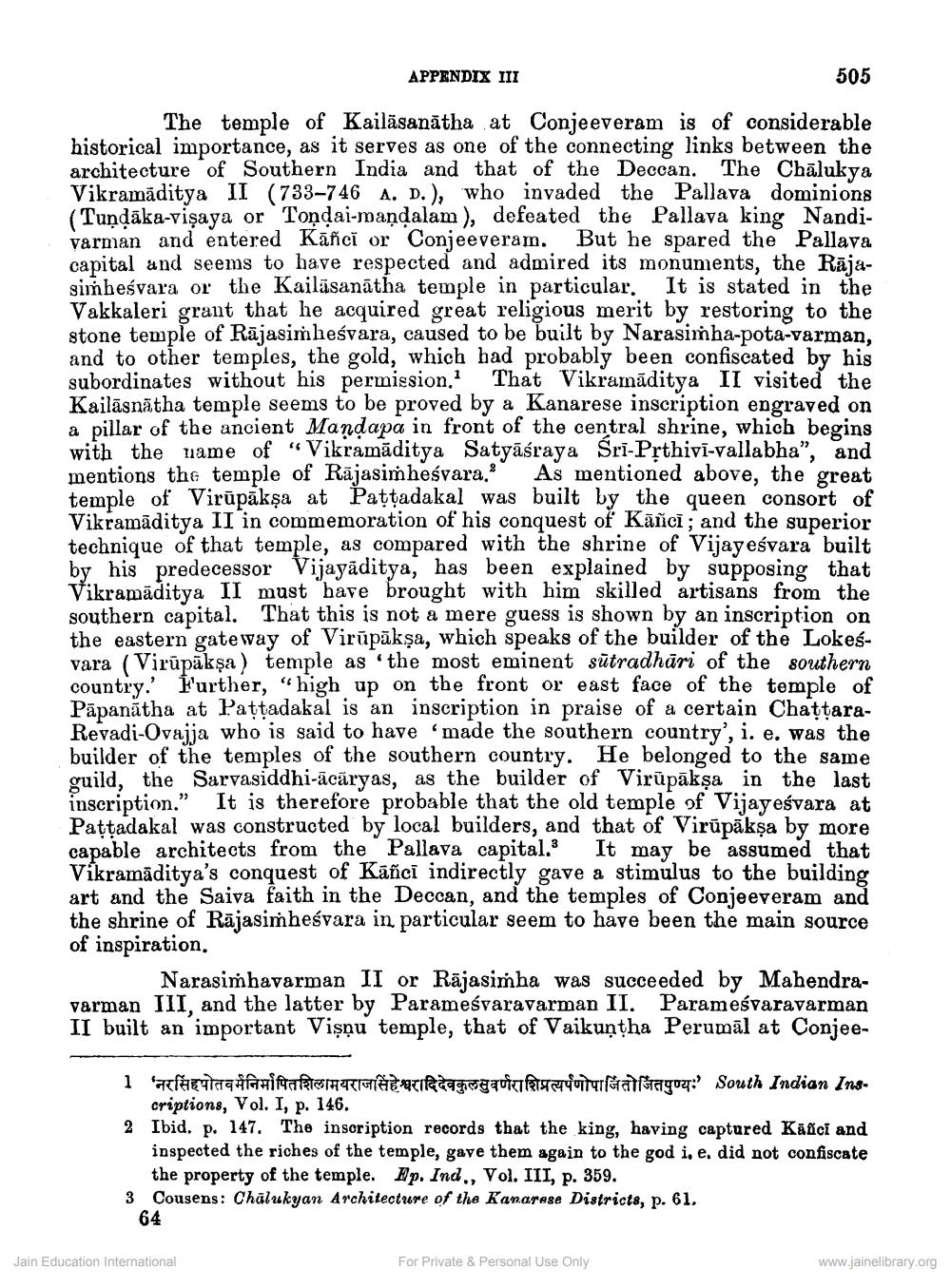________________
APPENDIX III
505
Kailāsnāth the ancient Mandmiditya Satyāśraya entioned above, the of
The temple of Kailāsanātha at Conjeeveram is of considerable historical importance, as it serves as one of the connecting links between the architecture of Southern India and that of the Deccan. The Chalukya Vikramaditya II (733-746 A. D.), who invaded the Pallava dominions (Tundāka-visaya or Tondai-mandalam ), defeated the Pallava king Nandivarman and entered Kāñci or Conjeeveram. But he spared the Pallava capital and seems to have respected and admired its monuments, the Rājasiṁheśvara or the Kailāsanātha temple in particular. It is stated in the Vakkaleri grant that he acquired great religious merit by restoring to the stone temple of Rājasimheśvara, caused to be built by Narasimha-pota-varman, and to other temples, the gold, which had probably been confiscated by his subordinates without his permission. That Vikramāditya II visited the Kailāsnātha temple seems to be proved by a Kanarese inscription engraved on a pillar of the ancient Mandapa in front of the central shrine, which begins with the name of "Vikramāditya Satyāśraya Sri-Prthivi-vallabha", and mentions the temple of Rājasimheśvara. As mentioned above, the great temple of Virūpākṣa at Pattadakal was built by the queen consort of Vikramāditya II in commemoration of his conquest of Kāñci; and the superior technique of that temple, as compared with the shrine of Vijayeśvara built by his predecessor Vijayāditya, has been explained by supposing that Vikramaditya II must have brought with him skilled artisans from the southern capital. That this is not a mere guess is shown by an inscription on the eastern gateway of Virūpākşa, which speaks of the builder of the Lokesvara (Virūpākşa) temple as the most eminent sūtradhāri of the southern country. Further, “high up on the front or east face of the temple of Pāpanātha at Pattadakal is an inscription in praise of a certain ChattaraRevadi-Ovajja who is said to have made the southern country', i. e. was the builder of the temples of the southern country. He belonged to the same guild, the Sarvasiddhi-ācāryas, as the builder of Virūpākşa in the last inscription." It is therefore probable that the old temple of Vijayeśvara at Pattadakal was constructed by local builders, and that of Virūpāksa by more capable architects from the Pallava capital. It may be assumed that Vikramaditya's conquest of Kāñci indirectly gave a stimulus to the building art and the Saiva faith in the Deccan, and the temples of Conjeeveram and the shrine of Rājasimheśvara in particular seem to have been the main source of inspiration.
Narasimhavarman II or Rājasimha was succeeded by Mahendravarman III, and the latter by Parameśvaravarman II. Parameśvaravarman II built an important Vişņu temple, that of Vaikuntha Perumal at Conjee
1 afhetaHaHARETRAITE ariage qui lutaralištagoz:' South Indian Ins
criptions, Vol. I, p. 146. 2 Ibid. p. 147. The insoription records that the king, having captured Kāfici and
inspected the riches of the temple, gave them again to the god i. e, did not confiscate
the property of the temple. Ep. Ind., Vol. III, p. 359. 3 Cousens: Chalukyan Architecture of the Kanarege Districts, p. 61. 64
Jain Education International
For Private & Personal Use Only
www.jainelibrary.org




